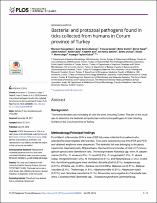Bacterial and protozoal pathogens found in ticks collected from humans in Corum province of Turkey

Göster/
Erişim
info:eu-repo/semantics/openAccessAttribution 4.0 International (CC BY 4.0)https://creativecommons.org/licenses/by/4.0/Tarih
2018Yazar
Karasartova, DjursunGüreser, Ayşe Semra
Gökçe, Tuncay
Çelebi, Bekir
Yapar, Derya
Keskin, Adem
Çelik, Selim
Ece, Yasemin
Erenler, Ali Kemal
Usluca, Selma
Mumcuoğlu, Kosta Yani
Taylan Özkan, Hikmet Ayşegül
Üst veri
Tüm öğe kaydını gösterKünye
Karasartova, D., Güreser, A. S., Gökçe, T., Çelebi, B., Yapar, D., Keskin, A., Çelik, S., Ece, Y., [et al.]. (2018) Bacterial and protozoal pathogens found in ticks collected from humans in Corum province of Turkey. PLoS Neglected Tropical Diseases, 12(4), e0006395.Özet
Background: Tick-borne diseases are increasing all over the word, including Turkey. The aim of this study was to determine the bacterial and protozoan vector-borne pathogens in ticks infesting humans in the Corum province of Turkey. Methodology/Principal findings: From March to November 2014 a total of 322 ticks were collected from patients who attended the local hospitals with tick bites. Ticks were screened by real time-PCR and PCR, and obtained amplicons were sequenced. The dedected tick was belonging to the genus Hyalomma, Haemaphysalis, Rhipicephalus, Dermacentor and Ixodes. A total of 17 microorganism species were identified in ticks. The most prevalent Rickettsia spp. were: R. aeschlimannii (19.5%), R. slovaca (4.5%), R. raoultii (2.2%), R. hoogstraalii (1.9%), R. sibirica subsp. mongolitimonae (1.2%), R. monacensis (0.31%), and Rickettsia spp. (1.2%). In addition, the following pathogens were identified: Borrelia afzelii (0.31%), Anaplasma spp. (0.31%), Ehrlichia spp. (0.93%), Babesia microti (0.93%), Babesia ovis (0.31%), Babesia occultans (3.4%), Theileria spp. (1.6%), Hepatozoon felis (0.31%), Hepatozoon canis (0.31%), and Hemolivia mauritanica (2.1%). All samples were negative for Francisella tularensis, Coxiella burnetii, Bartonella spp., Toxoplasma gondii and Leishmania spp. Conclusions/Significance: Ticks in Corum carry a large variety of human and zoonotic pathogens that were detected not only in known vectors, but showed a wider vector diversity. There is an increase in the prevalence of ticks infected with the spotted fever group and lymphangitis-associated rickettsiosis, while Ehrlichia spp. and Anaplasma spp. were reported for the first time from this region. B. microti was detected for the first time in Hyalomma marginatum infesting humans. The detection of B. occultans, B. ovis, Hepatozoon spp., Theileria spp. and Hemolivia mauritanica indicate the importance of these ticks as vectors of pathogens of veterinary importance, therefore patients with a tick infestation should be followed for a variety of pathogens with medical importance. © 2018 Karasartova et al.
Kaynak
PLoS Neglected Tropical DiseasesCilt
12Sayı
4Koleksiyonlar
- Makale Koleksiyonu [198]
- Makale Koleksiyonu [517]
- PubMed İndeksli Yayınlar Koleksiyonu [949]
- Scopus İndeksli Yayınlar Koleksiyonu [2695]
- WoS İndeksli Yayınlar Koleksiyonu [2986]


















